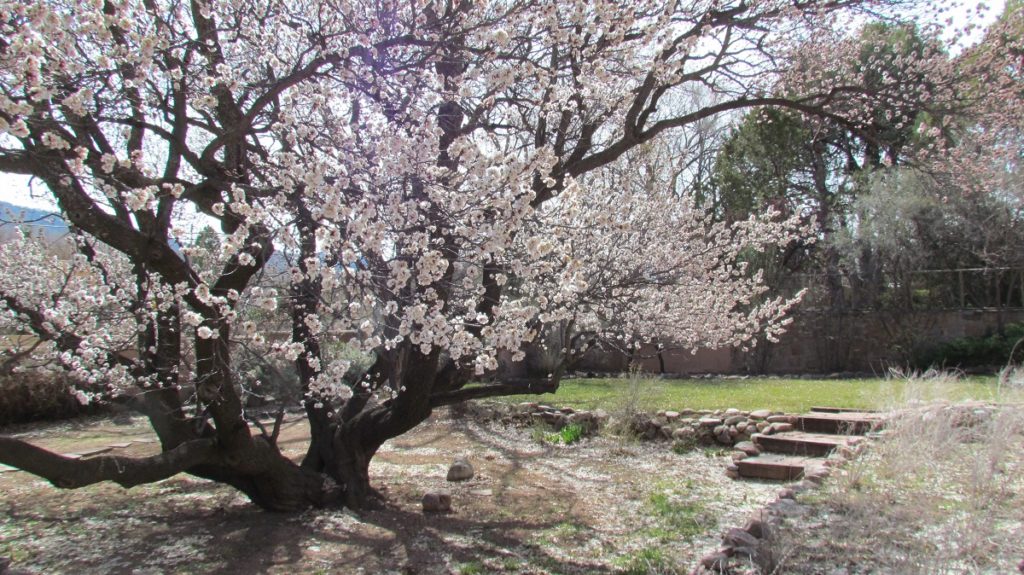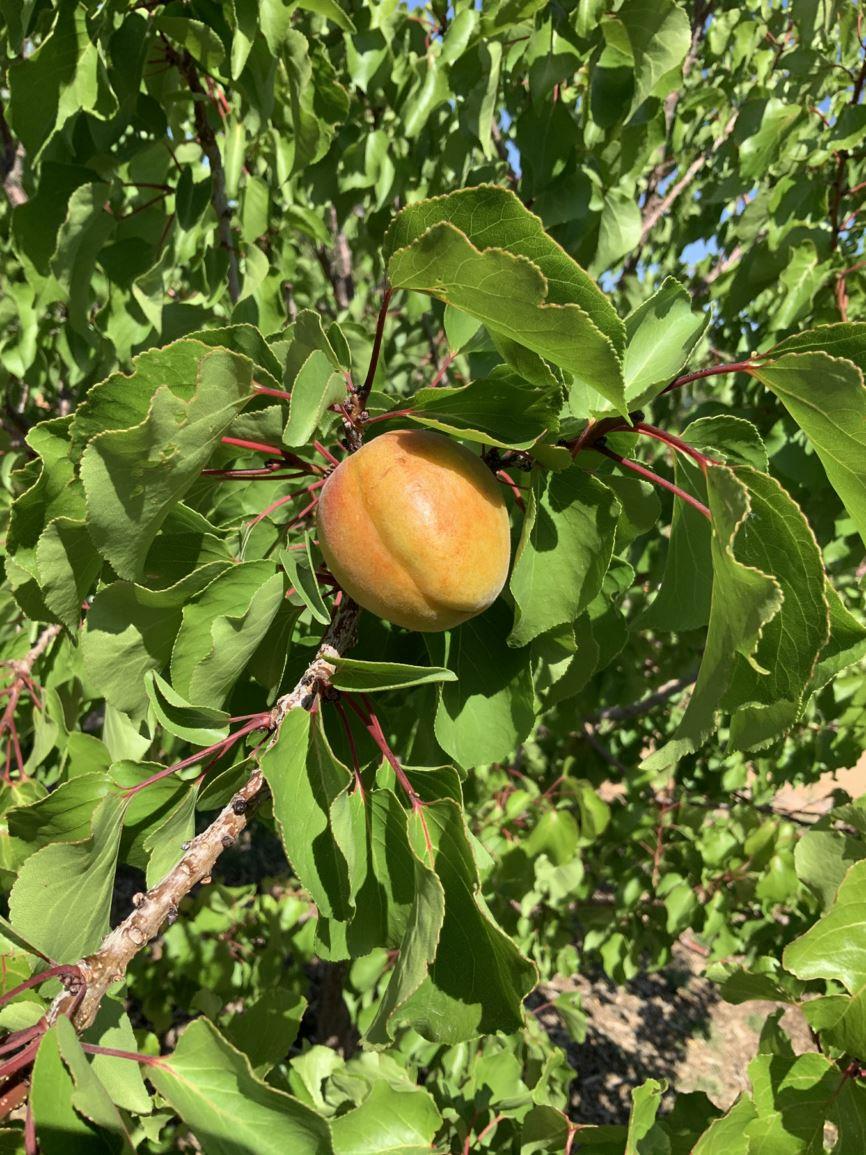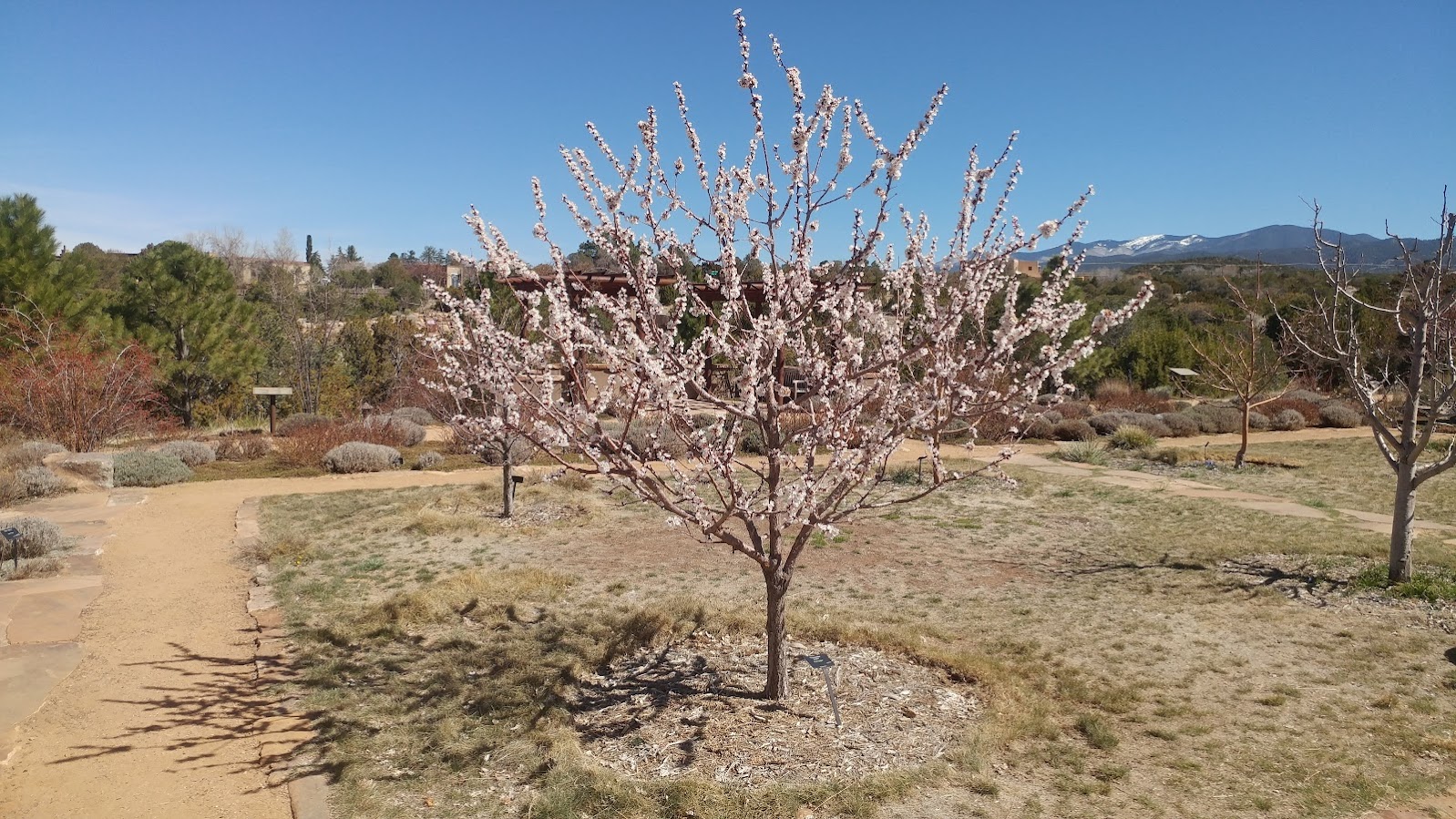Scientific name: Prunus armeniaca
Common name: apricot
Family: Roseace (rose)
Life form: Herbaceous perennial plants or annual plants (depending on species)
Article by Linda Churchill, Director of Horticulture
Disclaimer: Apricot is this author’s favorite tree (and fruit).
Along with the heady smell of green chile roasting in the fall and the beauty of crabapple blossoms decking the city in mid spring, the sight and flavor of fresh ripe summer apricots is one of the iconic sensual delights in our city of enchantment.
Every year the denizens of Santa Fe wait with excited anticipation or trepidation—or both– for the ripening of the apricot fruits in late July. It seems that all at once apricots are falling off trees faster than we can pick them, making a sticky mess of the streets and sidewalks. But oh, that sun-kissed sweet-tangy flavor, yours for the picking if you are lucky enough to have a neighbor with a large tree, or even better, a tree in your own yard! Apricot jam is one of my favorite foods and our family puts up as many jars as we can in the abundant years.
Of course, apricot trees don’t fruit every year in Santa Fe. Our apricots blossom valiantly in March or early April, the first fruit trees to bloom, attracting early bees starved for nectar and pollen. But the delightful pale pink buds and blossoms, opening far earlier than those crabapple flowers, are hit as often as not by our spring frosts, freezing the flowers and dashing the hopes of jam enthusiasts for that year’s harvest.
- Photo: Janice Tucker
- Photo: Cristina Salvador
- Photo: Janice Tucker.
The apricot was originally cultivated in China around 3,000 B.C.E. from wild populations in south and north central Asia. From China it was introduced to the Middle East and throughout the Eurasian steppe by nomadic tribesmen and Silk Road traders. The species name armeniaca refers to Armenia, where the apricot was once thought to originate. Apricots have flourished for millennia throughout the Mediterranean and the Levant, where they have become part of the various cultures of those regions and seem to retain a little of the mystique of those ancient, poetic lands.
Santa Fe’s situation in the North American steppe, with its high, dry climate and nearby mountain ranges, is similar to the Eurasian steppe where apricots grow so well. The climate and geography of Armenia, Turkey, and Iran give a clue as to ideal growing conditions for this tree: moderately cold winters and summer heat with dry but not desert conditions.

Santa Fe meets these conditions and is indeed a natural home for the apricot tree, which has flourished here for some time. It was introduced California by the Spanish in the 18th century, but was also observed growing in the Santa Fe area by Fray Alonso Benavides in the late 1620’s. Many of the older trees in Santa Fe likely grew not from carefully cultivated varieties but as seedlings that sprouted happily where pits had been thrown the previous summer. The same has happened on my own property!
Apricots are grown and enjoyed around the world today. Not suprisingly, Turkey, Uzbekistan and Iran are the top producing countries. In the United States California is the leader, producing around 90% of the country’s fresh and dried fruits.
Apricots require less water, pruning, and other maintenance than most other fruit trees, although judicious watering can help produce larger, juicier fruits. Moderately fertile, well-drained soil is ideal but the trees can tolerate less ideal soil as long as it is not water-logged. They thrive in areas with dry spring weather and long, hot summers but they do need some winter cold in order to blossom and grow well. It is helpful to grow them in a spot where spring sun will not allow them to bloom too early, or conversely in a location protected from late spring freezes. Later-blooming cultivars are ideal for places like Santa Fe where spring temperatures can regularly vary from warm to quite cold. Trees are self-fruitful although it is beneficial to have more than one tree for best pollination.
Apricot fruit is a drupe, with a hard pit and slightly fuzzy edible skin. Fruit color ranges from creamy yellow to bright orange. As with other plants in the rose family, the apricot blossom has five petals with many stamens. The alternate leaves are ovate with a rounded base and pointed tip, somewhat heart-shaped. Bark on mature trees is gray-brown and can be slightly fissured or corrugated; younger bark has noticeable lenticels. Apricots do not typically have many pest and disease issues although some fungi, bacteria and insects can cause damage. Stressed trees are more susceptible to problems; trees grown in good conditions, with moderate moisture, are less susceptible to pests. Sunscald is an environmental problem that can lead to other stressors; protect young tree bark from winter and spring sun damage by wrapping the tender bark or painting it white (50/50 mix of latex paint and water) for a couple years after planting.
Apricot trees can be a lovely landscape addition even without their delicious fruit. Trees not specifically pruned for fruit production are typically moderately sized (15-20’ tall and wide) with a rounded canopy and naturally sturdy structure. They can live from 30 to 100 years, although there are at least a few in Santa Fe that have been estimated at 120 or more years old. That early spring bloom is of course lovely but the autumn leaf color from soft yellow to brilliant gold can be equally captivating, making it a very attractive tree year round.
- Prunus armeniaca ‘Harglow’ in spring (April 2019).
- Prunus armeniaca ‘Harglow’ in fall (September 2019).
References
Dunmire, Willian W. Gardens of New Spain, University of Texas Press, 2004, p. 175.
Britannica, The Editors of Encyclopaedia. “apricot”. Encyclopedia Britannica, 25 Apr. 2024, https://www.britannica.com/plant/apricot. Accessed 10 June 2024.
Denker, Joel S. “ ‘Moon Of The Faith:’ A History Of The Apricot And Its Many Pleasures,” The Carrot Purple And Other Curious Stories Of The Food We Eat. Rowman & Littlefield Publishers, 2015 Illustrated edition. Accessed 10 June 2024. Retreived from: https://www.npr.org/sections/thesalt/2016/06/14/481932829/moon-of-the-faith-a-history-of-the-apricot-and-its-many-pleasures
“Apricot Production by Country 2024,” World Population Review, 2024. Accessed 10 June 2024. Retreived from: https://worldpopulationreview.com/country-rankings/apricot-production-by-country
“Growing an Apricot Tree,” Raintree Nursery, 2024. Accessed 10 June 2024. Retreived from: https://raintreenursery.com/collections/apricot-trees
“Domestication history of apricots retraced through genomics,” INRAE National Research Institute for Agriculture, Food and Environment, 2021. Accessed 10 June 2024. Retreived from: https://www.inrae.fr/en/news/domestication-history-apricots-retraced-through genomics#:~:text=Long%20considered%20native%20to%20China,population%20in%20southern%20central%20Asia.







